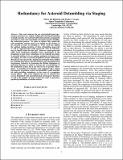Redundancy for Asteroid Detumbling via Staging
Author(s)
Jia-Richards, Oliver; Lozano, Paulo C
Downloadieee_aeroconf_2021.pdf (3.959Mb)
Open Access Policy
Open Access Policy
Creative Commons Attribution-Noncommercial-Share Alike
Terms of use
Metadata
Show full item recordAbstract
This work analyzes the use of microfabricated elec-trospray thrusters in a staged configuration during detumbling of small asteroids. For asteroid redirection missions, keeping the asteroid in a static and controllable orientation greatly simplifies the redirection process. In order to achieve this, spacecraft with propulsion systems need to be landed on the surface of the asteroid in order to detumble it. Prior work has studied the optimal landing locations of these detumbling spacecraft as well as suggested that small spacecraft, such as CubeSats, may be ideally suited for this task. However, small spacecraft suffer from component reliability issues, particularly in the propulsion system where redundancy is not typically provided. A potential solution is to use staging, analogous to launch vehicle staging, in order to provide propulsion system redundancy directly on each spacecraft. Staging has primarily been studied for enabling deep-space CubeSat missions with microfabricated electrospray thrusters by bypassing the lifetime limitations of individual thrusters in order to increase the overall lifetime of the propulsion system, but it can also be use to provide redundancy. A small fleet of CubeSats, each equipped with a staged electrospray propulsion system can detumble a small asteroid, all while providing redundancy in the event of a propulsion system failure. This work estimates the size of asteroid that can be detumbled with microfabricated electrospray thrusters as well as the number of stages required in order to guarantee specified probabilities of mission success.
Date issued
2021-06Department
Massachusetts Institute of Technology. Space Propulsion LabJournal
2021 IEEE Aerospace Conference
Publisher
Institute of Electrical and Electronics Engineers (IEEE)
Citation
Jia-Richards, Oliver and Paulo Lozano et al. "Redundancy for Asteroid Detumbling via Staging." 2021 IEEE Aerospace Conference, March 2021, Big Sky Montana, Institute of Electrical and Electronics Engineers (IEEE), June 2021. © 2021 IEEE
Version: Author's final manuscript
ISBN
9781728174365